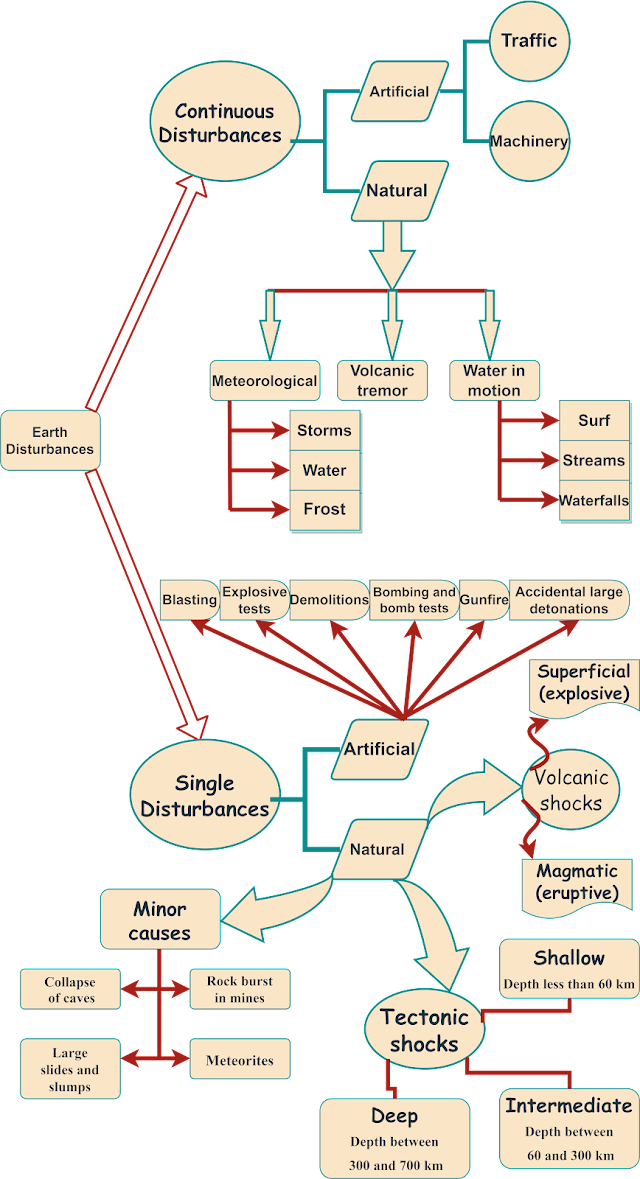How much bigger is one earthquake than another?
Click Here ⇒ Calculator
Earthquake
An earthquake is a sudden
and often violent shaking of the ground caused by the movement of tectonic
plates in the Earth's crust.
An earthquake is a sudden
and violent shaking of the Earth's surface caused by the release of energy
stored in the Earth's crust. This energy is typically released along a fault
line, due to the movement of tectonic plates. Earthquakes can range in size from
small tremors that are barely noticeable to catastrophic events that can cause
widespread damage and loss of life. Earthquakes can cause widespread damage and
loss of life, especially in heavily populated areas.
- · A sudden shaking of the Earth's surface
caused by the release of energy in the Earth's crust.
- ·
Caused by the movement of tectonic plates
along fault lines.
- ·
Range in size from small tremors to
catastrophic events.
- · Can cause widespread damage and loss of
life.
The energy may arise from numerous causes, such as distortions of the crust, eruptions of volcanoes, or even from man- made explosions or the collapsing of underground grooves, such as mines or karsts. Thus, while earthquakes are considered as natural disturbances, many types of earthquakes exist: fault rupture- generated, volcanic, mining- induced and enormous reservoir- induced. Richter (1958) compiled a list of notable earth disturbances observed by seismographs
Figure: Earth disturbances recorded by seismographs
The intensity of an earthquake
Intensity is a non-
instrumental perceptibility measurement of damage to buildings, ground surface
effects, e.g., fractures, fissures and landslides and human responses to
earthquake shaking.
Seismic intensity is a
measure of the effects of an earthquake on the Earth's surface, humans, and
man-made structures. It is distinct from earthquake magnitude, which is a
measure of the energy released by an earthquake.
It is a qualitative
approach which has been commonly used to assess earthquake size, especially for
prior to instrumental occurrences. It is a subjective damage rating measure
because of its qualitative character, connected to population density, experience
with earthquake and kind of structures.
There are many types of
seismic intensity scale. Some of the most prominent intensity scales are given
below:
Figure: Types of Intensity Scale
The magnitude of an earthquake
Earthquake magnitude is a
measure of the relative size of an earthquake, based on the energy released at
its hypocenter. It is a logarithmic scale, which means that each whole number
increase in magnitude represents a tenfold increase in energy release. It is
therefore conforming an instrumental, quantitative and objective scale.
Whereas the intensity of
a specific earthquake changes from one observation location to another,
earthquakes may be connected with a single value of magnitude. The consensus
measure of magnitude is based on the Richter scale, which identifies the size
of an earthquake with an indicator of the amount of energy released, and while
this approach is an improvement as compared to the intensity scales, the
Richter scale does not accurately take into account for all factors that
contribute to the actual size of an earthquake. This scale, however, does
accurately represent the relative intensity of an earthquake and remains an
essential metric in seismic hazard research. In addition to being used for
earthquake hazard assessments by seismologists and engineers, it is the primary
scale used to inform the public of the magnitude of an earthquake.
There are several scales to measure magnitude. Because they measure the amplitudes of seismic waves with various characteristics, many of these scales are frequency dependent. Scales that are directly connected to source parameters have also been proposed. These are frequency independent since they are not reliant on certain waves. The most often used magnitude scales are shown below.
Figure: Types of Magnitude Scale
Properties of major magnitude scales
Table: Properties of major magnitude scales
Key Point: Intensity Vs. Magnitude
Magnitude is proportional to the amount of energy
released as a result of plate movement. It has a distinctive value for an
earthquake. It ranges from one to ten.
Intensity is connected to human emotions, secondary structure behavior, and structural behavior. For a certain earthquake, it has varying values at different sites. It ranges between I and XII and between I and VII.
There are two key points to remember when
considering earthquake magnitude:
• As the magnitude of an earthquake rises by
one whole number, its size increases by a factor of 10. A magnitude 7.0
earthquake is therefore 10 times greater than a 6.0 earthquake; a magnitude 8.0
earthquake is 100 times larger; and a magnitude 9.0 earthquake is 1,000 times
larger than a 6.0 earthquake.
•
However, the quantity of energy released
rises by a factor of around 32. A magnitude 7.0 earthquake releases 32 times
more energy than a magnitude 6.0 earthquake; a magnitude 8.0 earthquake
releases around 1,000 times more energy; and a magnitude 9.0 earthquake
releases approximately 32,000 times more energy than a magnitude 6.0
earthquake. It's simple to understand why earthquakes of magnitude 8.0 and 9.0
produce such broad devastation and loss.
Reference:
- Fundamentals of Earthquake Engineering-Amr S. Elnashai, Luigi Di
Sarno
- https://www.usgs.gov/




